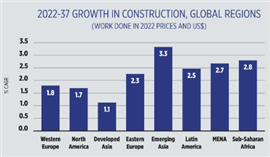What the Global Construction Guide 2024 tells us about the state of play in international construction
21 December 2023
As 2023 draws to a close, the latest edition of the Global Construction Guide offers a snapshot of how a range of different sectors of construction have performed.
The Global Construction Guide 2024 uses a set of exclusive ‘top lists’ compiled by KHL Group’s editorial team in sectors such as construction, rental, cranes, access and demolition and recycling and puts them all into one place.
So what do these lists tell us about the state of play in the global construction market over the past year?
Most obviously, they reveal two macro trends: A surprisingly strong performance from the US construction market, compared with a weakening sector in China, as it continues to grapple with a drawn-out property crisis.
The CHIPS Act aimed at catalysing the semiconductor industry in the USA has sparked a glut of industrial construction projects, while the far-reaching $1.2 trillion Bipartisan Infrastructure Law, now two years old, has spurred infrastructure projects across the USA, even as higher interest rates dampened demand for residential construction.
By contrast, China has been grappling with a property crisis, signalled by the collapse of the debt-laden Evergrande Group, the fallout from which has stifled construction demand. It comes at a time when China has scaled back its 10-year-old Belt and Road Initiative (BRI), as it starts to switch away from heavy investment in hard infrastructure projects that benefited Chinese construction contractors and OEMs to ‘small and beautiful’ low-investment, high-yield projects.
Top lists illustrate strong US and struggling China
International Construction’s list of the top 200 biggest construction companies in the world is a lagging indicator in the sense that it ranks companies according to their annual revenue. 2023’s list is therefore based on companies 2022/23 financial year but it nonetheless showed the direction of travel.
While five Chinese firms still dominated the top slots, headed by China State Construction & Engineering Company (CSCEC) on sales of $303.4 billion, the share of the top 200 companies’ revenue accounted for by Chinese firms stayed flat at 44%.
By contrast, US companies increased their revenue share from 12.5% in 2022, to 13.7% in 2023, and of the 33 US companies in the list, 21 saw their placings increase, while three stayed the same and only nine fell.
The 2023 Yellow Table, which ranks the 50 biggest construction equipment OEMs in the world and also features in the Global Construction Guide 2024, told a similar story.
Revenues generated in the Yellow Table from Asias firms fell from over half of the total amount in 2022 (50.2%) to 44.8% in 2023. The main reason for that was a decline in China. The top Chinese OEMs to feature in the list saw a collective decline in their share of the revenue to 18.2%, down from 25% on the previous year.
The IRN100 list of the world’s top rental companies also highlighted a disparity in growth between North America and most of the rest of the world.
Data compiled from the table, which ranks rental companies on their annual revenue, showed average growth of companies in the US and Canada at 14.9%, compared to 4% elsewhere, with the exception of China. The top three companies – United Rentals, Sunbelt and Herc are entirely or mostly active in that region.
China’s companies still expanded at a strong rate but analysis of the IRN100 also pointed to a cooling down in the region.
Chinese market still huge…but not the driver of growth it once was
China is still set to remain an outsized influence in the global construction sector, according to analysis included in the Global Construction Guide 2024.
By 2037, it is predicted to hold the top spot as the world’s biggest construction market, with a 31% share (based on 2022 prices and US$), compared to 13% for the US and 7% for India. But the rate at which construction work in China grows is likely to slow over the next 15 years as its population starts to fall, according to economists at Oxford Economics.
Growth is still expected to be significant. The government plans to build 200,000km of railways, 460,000km of highways and 25,000 of high-level sea lanes by 2035, according to Oxford Economics’ Global Construction Futures report. But other regions are likely to outstrip it.
 2022-2037 growth in construction global regions (work done in 2022 and US$ prices). [Source: Oxford Economics/Haver Analytics]
2022-2037 growth in construction global regions (work done in 2022 and US$ prices). [Source: Oxford Economics/Haver Analytics]
Economists also predict that ‘emerging Asia’ will see a 3.3% compound annual growth rate (CAGR) between 2022 and 2037 (based on work done in 2022 prices and US$), which his higher than any other region.
While ‘emerging Asia’ includes China, it also incorporates India, Indonesia, Malaysia, the Philippines, Thailand and Vietnam.
And it’s India where some of the highest construction growth could come over the next 15 years, according to Oxford Economics. They predict growth there to be higher than in the US, as the world’s most populous country becomes a near US$1 trillion global construction powerhouse.






